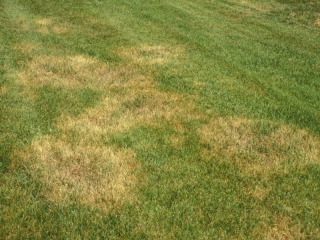Many signs can point to diseased grass, but a part of them are only indications of poor gardening. Taking into account this consideration, it is rather difficult to diagnose precisely if it`s about diseased grass or not. For example, if you see yellow and brown spots on the lawn, this can mean you over-fertilized and burn it. Below you can find some guidelines that will help you figure out what is happening with your lawn.
You should monitor all changes in the grass, as dangerous pathogens and fungal spores can be noticed. It is advisable to make a log book where you write information about the time you fertilize, mow, water and dethatch the grass, as well as other signs and weather conditions. For example, lawn can develop a disease, leaf spot, due to the warm moist weather of the spring, while cool weather can lead to rhizoctonia yellow patch.
In diagnosing diseased grass, there are two main symptoms: discoloration and spots. If you see circular discolored patches on the grass, it can mean you have to face diseased grass. In case grass areas feature uneven green, gardeners should keep those areas under observation for grass diseases such as summer patch, sclerotinia dollar spot or rhizoctonia blight. Write in the log book any changes in the weather conditions, but also note what fertilizers and herbicides you have applied. Discoloration can be generated by the cultural factors above, so pay attention to all these details.
Your yard might have got a fungal disease if it features spotty grass blades. Do not forget to observe and make notes referring the size and color of spots on grass blades, as this can make it easier to determine the exact disease. When dew is still present in the morning, go to your lawn and search for fungal structures growing on the grass. You should be looking for matter, white fungal growth similar to cotton candy.
Keep track by writing all signs of spots, wilting, unhealthy growth, discoloration or other unusual features. You should also specify the date, time of day and weather conditions. You will realize that lawns get infected by specific fungal disease every year. By having notes about what happened the previous year, you can apply the right fungicides the following year before that date so that you can prevent it.
Do not forget that wrong mowing procedure can also encourage the appearance of diseases. If you use dull blades or cut your lawn too short, it is very probable for the grass to contact a disease, so use the proper procedure.












































